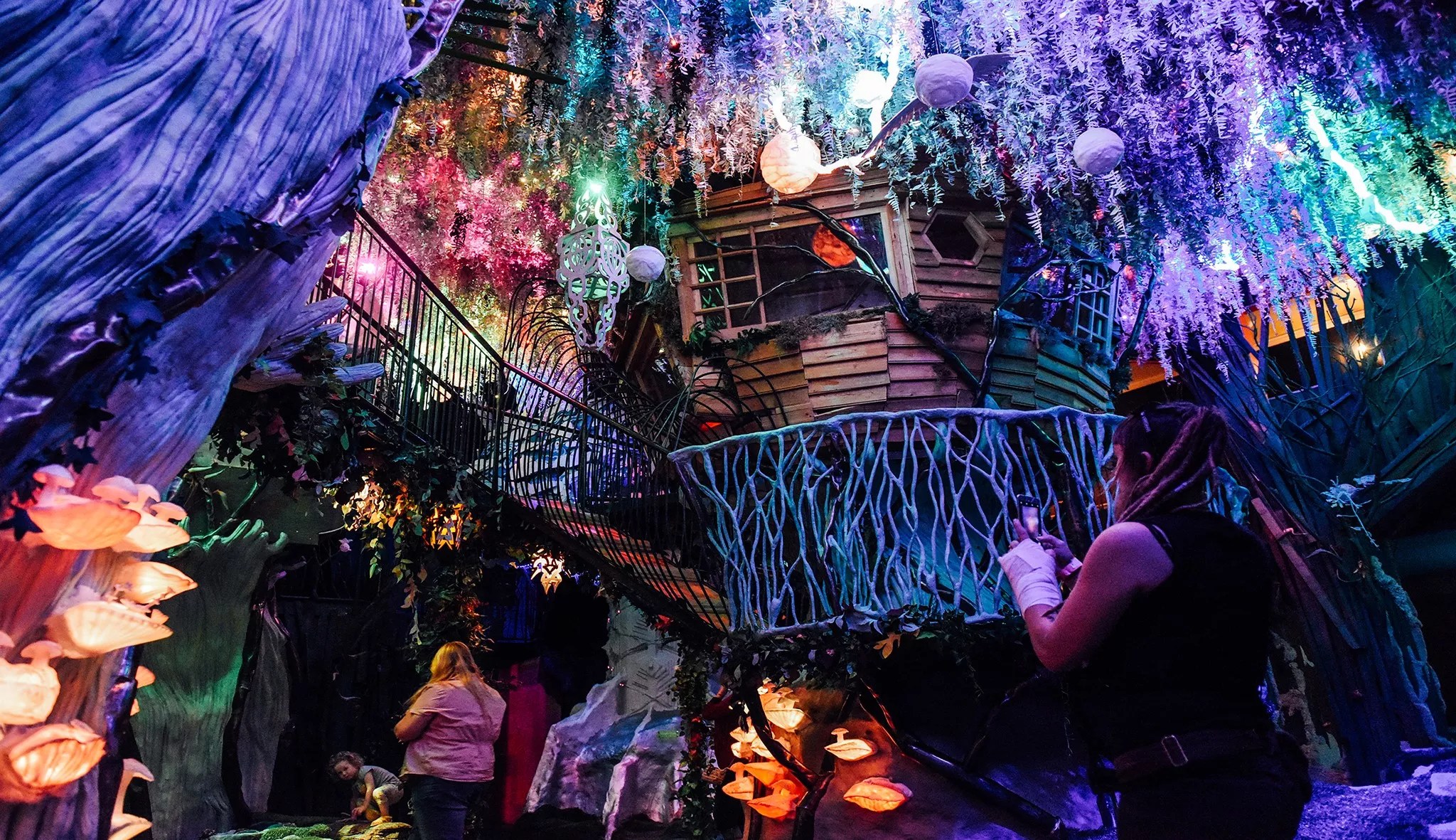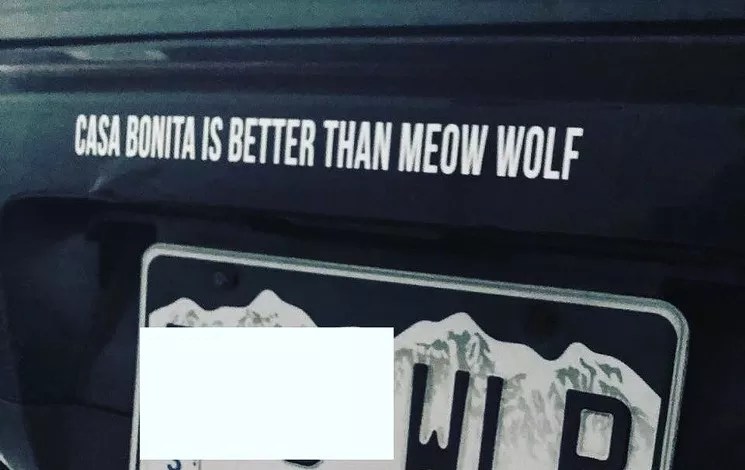
Kenzie Bruce

Audio By Carbonatix
When Phoenix-based art critic and Heard Museum curator Erin Joyce slammed Meow Wolf in the online culture journal Hyperallergic this week, the experiential, immersive-arts company bit back, and a pack of supporters followed on social media.
In her essay, Joyce took on Meow Wolf and its recently announced Phoenix hotel project, complete with 75,000 square feet of exhibit space and 400 rooms, which is slated for the rapidly gentrifying Roosevelt Row Arts District, once a scrappy downtown home to artists, many of whom who can no longer afford to live in the neighborhood. Joyce wrote that Meow Wolf’s hotel could hasten that process, labeling as “vaguely colonial” the group’s original hit, The House of Eternal Return in Santa Fe, and arguing that Meow Wolf is “tone-deaf” to indigenous people.
Her diagnosis: “The problem with Meow Wolf is that it is a supreme act of late stage capitalism disguised through the collective’s mantra of the underdog as art savior.”
Those are harsh words for an enterprise that started just over a decade ago as a DIY collective of ten, which exploded after a massive influx of cash from Game of Thrones author George R.R. Martin. The House of Eternal Return opened in March 2016 in an old bowling alley in an industrial area of Santa Fe to raves from around the globe.
But the Hyperallergic essay is not the first time Meow Wolf has heard this message – not even from Joyce. She shared her concerns with Artnet back in 2016. And she wasn’t the only person grumbling about Meow Wolf that year. A Santa Fe resident named Hernan Gomez expressed his feelings on a sign reading, “Welcome, Gentrifiers. Keep pushing us out! Consequence: we lose space, you lose culture,” Hyperallergic reports.
Denver artists and activists privately shared similar trepidations when Meow Wolf announced in January 2018 that it would be partnering with Revesco Properties (Elitch Gardens) on a gigantic outpost at the juncture of I-25 and West Colfax Avenue, close by the Sun Valley neighborhood, once Denver’s poorest. Although that project isn’t slated to open until late 2020, Meow Wolf quickly began reaching out to artists of color, women and queer people; creating a fifteen-member community advisory committee; offering grants for DIY projects and small arts groups; and concentrating on Colorado artists in its first call for proposals for work at Meow Wolf Denver issued last fall.
“As we build and grow in Denver, Meow Wolf is making a commitment to our guests, employees, neighbors, and planet that we will be leaders in ethical business practices. We will focus on four areas where our commitment and scale can make the biggest impact: Community, Artists, Environment and Economy,” the group says above a link to the Meow Wolf Denver Corporate Social Responsibility page on meowwolf.com.
While some artists and activists are still griping about Meow Wolf Denver, most are doing it behind closed doors. Meanwhile, arts groups around town are touting events as “immersive,” and Jenny Weinbloom, executive producer of Meow Wolf Denver, offered the closing keynote at the first Denver Immersive Summit last November.
As the same time, though, two Denver artists, Esteban Peralta and Sommer Browning, created a bumper sticker reading, “Casa Bonita Is Better Than Meow Wolf.” In response, Meow Wolf offered jovial, self-deprecating remarks and some mild trolling on Twitter, thanking Peralta for the free publicity.
But the duo’s message came through: Is Meow Wolf doing anything more innovative than Casa Bonita?

Denver artists took a jab at Meow Wolf.
Courtesy Estaban Peralta
Joyce’s essay expanded on that question, essentially asking: What is Meow Wolf doing for culture as a whole?
That’s a valid question, and it’s a critic’s job to ask it. For people who care about art as a political and social tool, Meow Wolf’s emphasis on spectacle can be a turnoff. Skeptics have equated The House of Eternal Return with the Museum of Ice Cream or Disney World, as just another kitschy consumer experience. But fans admire the stories created within the space, spend hours in The House of Eternal Return and look forward to doing so at the company’s other installations. (A Meow Wolf will open in Las Vegas this year; one in Washington, D.C.,will debut the year after Denver’s.)
After Joyce’s essay appeared, Meow Wolf offered a response on Facebook, saying that it understands her concerns and pointing out that the company is collecting community feedback on the Phoenix project. At the same time, Meow Wolf was quick to defend itself: “We provide a creative, artful experience to 500,000 visitors per year in Santa Fe (a town of 70,000 people), and we currently employ over 400 artists on salary and with full benefits!”
Ultimately, Meow Wolf dismissed the Hyperallergic story as sour grapes because the company had refused to advertise with the publication.
“It’s important to note here that Hyperallergic has had a few individuals from their organization who have publicly expressed their grudges with our company,” wrote Vince Kadlubek, an original member of the Meow Wolf collective and now Meow Wolf’s CEO, on Facebook. “The editor-in-chief proclaimed on Twitter that he’d never support us. A writer from a previous article has expressed that he hopes we fail. And this writer has had a long-standing feud with us since 2015.”
“We have refused to spend marketing dollars with Hyperallergic, and what you are witnessing is what i’d call a ‘weaner battle,'” he added. “But with that said, we actually do take these issues that are raised VERY seriously, and have dedicated quite a bit of resources to addressing them. I encourage everyone to visit our website or our Facebook page to learn more about all the work we are doing with social impact, diversity, and philanthropy.”
Vartanian denies having said he would never support Meow Wolf, though he did state he would not write about the company. He was not the editor of Joyce’s piece.
While Meow Wolf has argued on Facebook that Hyperallergic is in bed with the art world because of the schools and museums that buy ads on the site, Vartanian denies that, too.
“The vast majority of our ads require New York (and to a lesser extent Los Angeles and San Francisco) traffic, so ads being sold elsewhere is minor for us and a small fraction part of our business,” he Vartanian. “New York subsidizes most other coverage.
“Meow Wolf has an over inflated sense of themselves,” he continues. “It’s the kind of remark about ads people who know nothing about the business make. And honestly, who knew this article about Meow Wolf would be popular. It’s kind of funny to me that it is.”
Meow Wolf sees it differently. “We know that we scare the traditional ‘Art World’ because we stand for something that is radically different than this model! So, honestly, this Hyperallergic article does not come as a surprise to us.”
Yet Joyce’s essay did not defend the behemoths of the art world; instead, she shared her fear that small galleries and DIY projects – projects that exist on a little spit, duct tape and goodwill – will be crushed by Meow Wolf.
“There are already fewer galleries on Roosevelt Row than a few years ago, and along Central Avenue in midtown Phoenix, a new multistory, hipster-vibe apartment building goes up every other month,” Joyce wrote. “A Meow Wolf Hotel just seems part of the larger gentrification that is displacing people with lower incomes to find shelter and studio space elsewhere.”
Compared to Meow Wolf’s response on Facebook, its Twitter behavior seemed almost rabid. Here Meow Wolf was far more aggressive, slamming Hyperallergic for hypocrisy and using the Meow Wolf name as clickbait, and lobbing other gripes at Joyce, the publication and its editor, Hrag Vartanian.
“The irony of it all here: This article has 6x more shares, and 100x more clicks than their 2nd most popular article,” Meow Wolf posted in a Facebook comment. “Which means ad revenue is going up for them.” (The Hyperallergic story “MASS MoCA Transformed a Struggling Mill Town Into an Art Hub” had far more shares and clicks, but, hey, who’s counting?)
Meow Wolf encouraged New Mexicans to come to the company’s defense, then accused Vartanian of ranting: “You said that you’d never write about us again, you deleted your tweets. C’mon man…these kind of games is what y’all wanna do with your time? HOW ARE YOU CONTRIBUTING TO CULTURE!”
Meow Wolf later deleted tweets attacking Vartanian.

Meow Wolf stands proud.
Kate Russell/Meow Wolf
Hyperallergic, which has built its reputation as a smart and contrarian force in arts criticism, has taken jabs before. “I see this issue with some art people who pretend to want critical dialogue but instead just want cheerleaders,” Vartanian tells Westword in an email.
He’s not the only one who’s felt Meow Wolf’s ire.
Anthony Cross, the editor of Salt, a Colorado-based arts and culture publication, says that after he published Natalie Scarlett’s review titled “Meow Wolf: I Can’t Believe It’s Not Better,” the company started taking swipes at the publication, and the attacks didn’t stop for two weeks. When he saw Meow Wolf’s tweets about Vartanian, he reached out to offer his consolation – and to express his shock that Meow Wolf was using its social-media platforms to harass journalists.
“That’s your corporate image,” Cross says. “That’s the voice of that business, right? I get that maybe a PR intern or one person is writing these things and writing it from their individual perspective. As a business, you have to understand that’s what’s coming from Meow Wolf’s Twitter. That’s what Meow Wolf thinks.”
As do some of its supporters. Denver artist Stephen Kruse, a member of the APEX Collective, sent this Facebook message to Joyce: “Hey Erin – just read your article on Meow Wolf. I spent about 20 seconds of my life to locate you so I can personally tell you: Fuck you and your shitty, unwarranted opinion. I hope your day is awful.”
Asked by Westword about his remarks, Kruse responds: “I’m sure you’ll understand that you can’t slander true art and not expect responses from true artists. Anyone can put out their opinions through blogs/social media, which gives everyone a chance to respond. My community is tight knit, full of love and creation. Meow Wolf is groundbreaking, and has built a stage for artists from around the world. They have done nothing but support the city/cities they reside in. My message to Erin was more just to show there is a voice behind what she is slandering. I speak for many.”
Joyce declined to comment for this story, as did a representative of Meow Wolf’s PR team. “At the moment, there is no one available from the Meow Wolf team to speak on behalf of their social media presence,” she wrote.
Meanwhile, the controversy continues on social media. On March 15, Vartanian says, somebody doxed Joyce on Twitter, revealing her personal information; he blocked them from his account.
“This reaction is very inappropriate,” Vartanian concludes. “Meow Wolf is acting like they’re scrappy kids, when the reality is very different.”
Update: This story was updated at 1 p.m. March 16 to include additional comments from Vartanian.